Introduction
In the era of data-driven decision-making, SPSS Data Editor has become an essential tool for professionals across industries. Whether you’re a researcher, statistician, or business analyst, IBM SPSS Statistics provides robust features to manage, analyze, and interpret data efficiently. This article explores how SPSS Data Editor enhances data handling and why it is crucial for the future of content writing and data analysis.
Table of Contents
Table of Contents
What is SPSS Data Editor?
SPSS (Statistical Package for the Social Sciences) is one of the most widely used statistical software tools. The SPSS Data Editor serves as the central interface where users enter, manipulate, and manage data. It functions like a spreadsheet but is far more powerful, offering advanced statistical operations, data visualization, and reporting capabilities.
Key Features of SPSS Data Editor
- User-Friendly Interface – Similar to Excel but designed for statistical operations.
- Data Management – Allows easy entry, sorting, and transformation of data.
- Statistical Analysis Tools – Supports a wide range of statistical tests and models.
- Customizable Output – Generates reports and visualizations for better insights.
- Seamless Data Import/Export – Works with CSV, Excel, SQL databases, and more.
Why SPSS Data Editor is the Future of Data Analysis
1. Efficiency in Data Handling
Data processing is a crucial aspect of any research or business operation. SPSS Data Editor simplifies data entry, modification, and analysis, ensuring that users save time while maintaining accuracy.
2. Advanced Statistical Capabilities
SPSS provides a comprehensive suite of statistical tools, including:
- Descriptive statistics (mean, median, mode, standard deviation)
- Regression analysis
- ANOVA (Analysis of Variance)
- Predictive modeling
These features help businesses and researchers make data-driven decisions with confidence.
3. Enhanced Data Visualization
With interactive charts, graphs, and tables, SPSS Data Editor allows users to create compelling reports that are easy to interpret. This makes complex datasets more digestible for stakeholders.
4. Seamless Integration with Other Tools
SPSS works seamlessly with various data sources such as Excel, SQL databases, and cloud-based platforms, making it easier to import/export data across multiple platforms.
How to Download SPSS for Windows
Many users search for ways to download SPSS for Windows for academic or professional purposes. Here’s a step-by-step guide:
- Visit the official IBM SPSS Statistics website.
- Choose the appropriate version (Standard, Professional, or Premium).
- Select the operating system (Windows 10 or later is recommended).
- Complete the registration and download the installer.
- Follow the installation prompts and activate the software using your IBM license.
Can I Download SPSS for Free?
SPSS is a premium software, but IBM offers a free trial version for a limited period. Students and educators can also access discounted academic licenses or check if their institution provides a free license.
Optimizing Your SPSS Data for Better Insights
To maximize the potential of SPSS Data Editor, follow these best practices:
- Clean Your Data – Remove duplicates, handle missing values, and standardize variables.
- Use Proper Labeling – Assign clear variable names and descriptions.
- Leverage Automation – Utilize built-in syntax for repetitive tasks.
- Regularly Update Your Software – Ensure you’re using the latest version for new features and security enhancements.
SPSS Data View and Variables View
An SPSS data file always has two tabs in the lower-left corner:
- The data view is where we inspect our actual data and
- The Variable View is where we see additional information about our data.

You can switch between data view and variables view
- by clicking on the tabs in the lower-left corner;
- using the hotkey Ctrl + t;
- double-clicking on the name of a variable in the Data View;
- by double-clicking a schematic number in Variable View.
Let’s first take a close look at the main parts of the Data View tab. Then we will proceed with the variables view.
SPSS data view

- The data editor has tabs for switching between Data View and Variable View. For now, make sure you are in Data View.
- The columns of cells are called variables. Each variable has a unique name (“gender”) that is displayed in the column header.
- The rows of cells are called cases. Often each respondent in a study is represented as a single case.
- In SPSS, the values refer to the content of the cell.
- The status bar can provide useful information about the data, for example, whether a WEIGHT, FILTER, SPLIT FILE, or Unicode mode is in effect.
These are the main elements of the Data View. Let’s now switch to the variable view.
SPSS Variables View
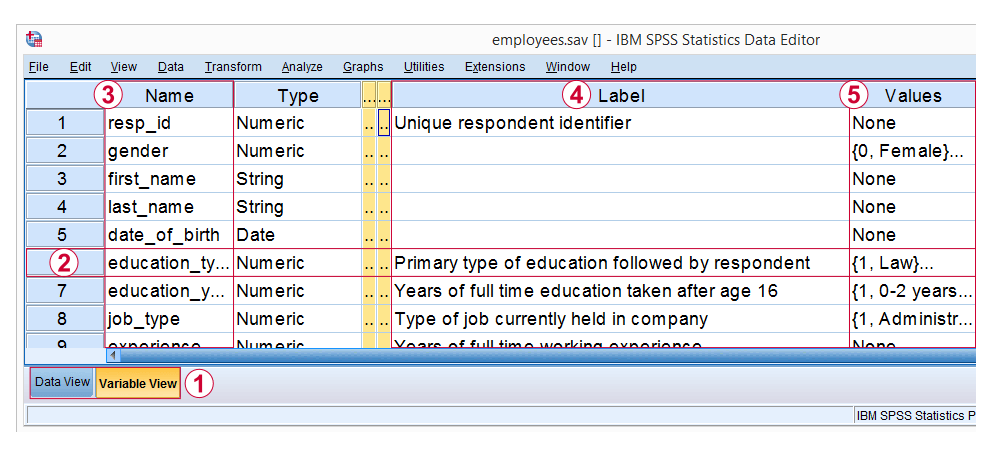
- In the lower-left corner, we find tabs to switch between Variable View and Data View. For now, select Variable view.
- In Variable View, variables are displayed as rows of cells.
- The first column shows the variable name for each variable.
- The fifth column may or may not contain a variable label. This describes the exact meaning of each variable.
- The sixth column shows value labels: descriptions of the meaning of one, many, or all of the values that a variable can contain.
In short, Variable View does not display the data itself, but rather information about the data. This is sometimes called “metadata” or “the codebook.” In SPSS, however, it is called a dictionary.This is important to know because you can find commands like DISPLAY DICTIONARY or APPLY DICTIONARY in manuals. If you are familiar with the syntax, running
DISPLAY DICTIONARY.
creates the output shown below: dictionary information as seen in the variables view.
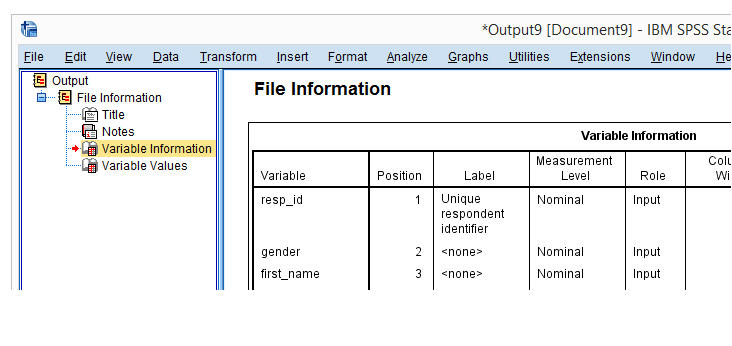
Dictionary information reported when executing DISPLAY DICTIONARY.
Variable View – Value Labels
For some variables, it is immediately clear what their values mean: a value of € 2,500, – in a variable “gross monthly income” represents a gross monthly income of € 2,500, -.However, this is not always the case: response categories for categorical variables are often represented by numbers, usually 1 through x. What these values represent is stored in their value labels. Clicking the open value labels icon for education type displays all value labels for this variable.

Value labels for education_type.
These value labels tell us that a person with a value of 1 in the education_type indicates someone who studied “Law.” Similarly, “Economy” is represented by a value of 2, and so on.
So far, we explained that the SPSS data editor always has 2 tabs:
Dictionary Information in Data View
So far, we explained that the SPSS data editor always has 2 tabs:
- Data view in which we inspect our actual data values and
- Variable view in which we find information about our data – dictionary information.
- What many SPSS users don’t know is that we can also see dictionary information in Data View. Let’s start with the value labels. Initially, we only see data values in the Data View as shown below.
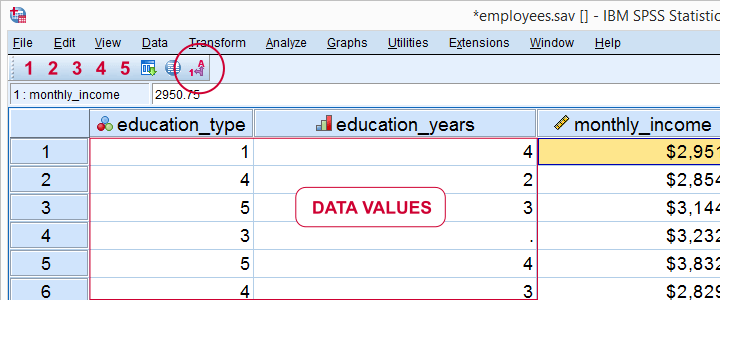
 we’ll see value labels instead of data values in data view.
we’ll see value labels instead of data values in data view.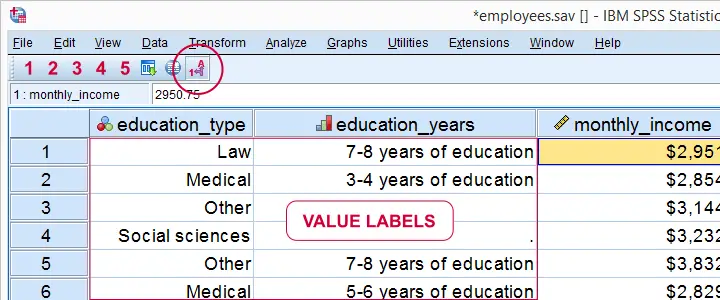
So this allows you to look up what your data means without having to switch between Data View and Variable View. Perhaps even more useful: place the mouse pointer on the name of a variable in Data View without clicking on it. Now a yellow box with a lot of information from the dictionary appears for a few seconds.
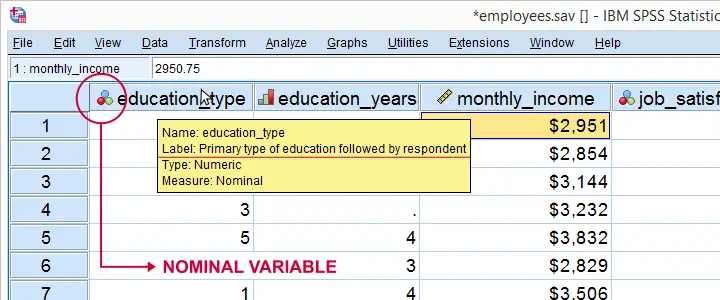
Variable view: value labels

Starting with SPSS version 22, the icons next to the variable names tell us something about our variable types, formats and measurement levels, that is, if they are configured correctly.
Final notes
So basically the “data” consists of 2 elements:
the data values we see in the Data View and Dictionary information about our data in the variables view.
We can save the content of the data editor as an SPSS data file or as a .sav file. If we do, the resulting file still contains everything in both the data view and the variable view.Again, let’s emphasize that you should never, under any circumstances, change anything manually in Data View or Variable View. This is possibly the worst SPSS practice. And yes, I know. Many SPSS users do this anyway.
But most, sooner or later, will wish they hadn’t.
The only efficient way to change the data or information in the dictionary is through syntax. Let’s move on to our next tutorial: Introduction to SPSS Syntax.
Conclusion
The SPSS Data Editor is an indispensable tool for modern data analysis. Whether you’re conducting research, analyzing business trends, or writing data-driven content, SPSS provides the precision, efficiency, and visualization needed for informed decision-making. If you’re looking to enhance your data analysis capabilities, consider downloading SPSS for Windows and explore its vast potential.
Thank you for reading.

good…I like
SPSS is popular statiscal tool.
SPSS is very useful statistical tool.
spss
SPSS is Fantastic statistical tools